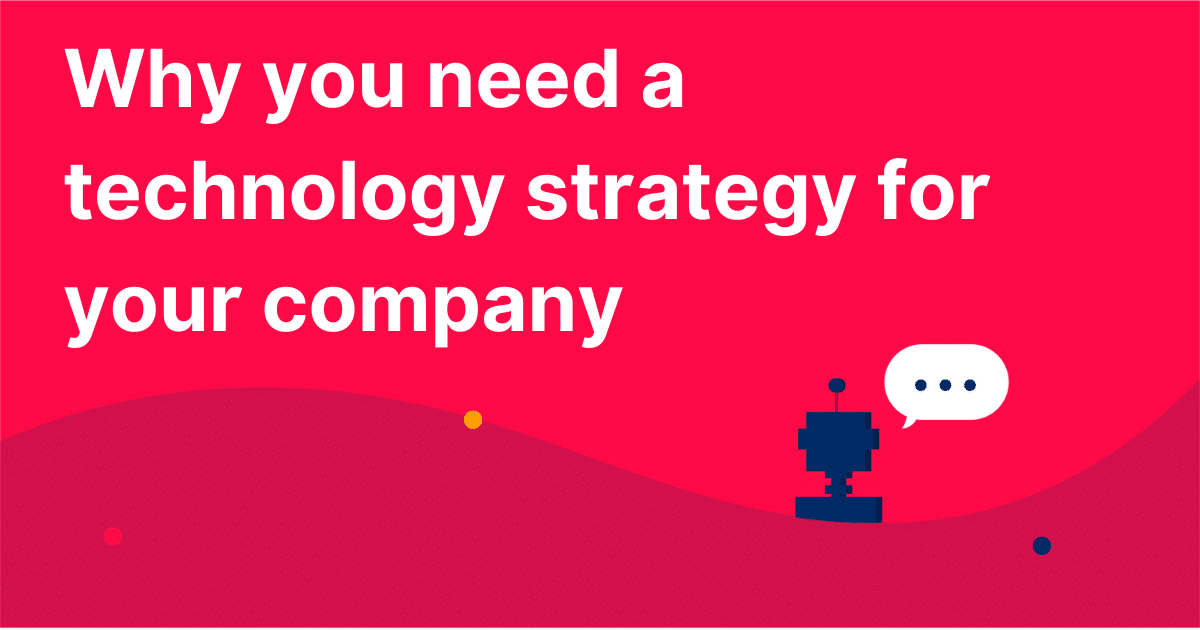Businesses can no longer afford to make ad-hoc or reactive tech decisions. That’s where a technology strategy comes into play. A technology strategy is a comprehensive plan that outlines how your organization will use technology to achieve its goals and objectives. It’s a roadmap for technology investments that ensures alignment and support for your company’s broader strategic objectives.
Unsurprisingly, digitally mature companies are 23% more profitable than their less mature peers. A well-defined technology strategy ensures all your technology initiatives are purposeful and integrated and contribute to business growth and success.
Moreover, a technology strategy acts as a guiding framework to mitigate risks associated with technology adoption. Without a clear technology strategy, your at risk of making ill-informed decisions. And that could then lead to wasted resources, disjointed systems, and missed opportunities. It also helps in enhancing efficiency, fostering innovation, improving customer service, and staying ahead of your competition. A technology strategy is a foundation for informed decision-making. And it lets company use technology as a powerful tool to drive business success.
4 ways to choose and implement the right technology for every department in your organization
1. Define clear objectives and requirements for all technology
The first step in formulating your technology strategy is clearly defining the objectives and requirements. Identify the goals your team hopes to achieve with the technology implementation. This can range from improving operational efficiency to enhancing customer service. Once the objectives are clear, determine the requirements and functionalities the technology solution must possess to meet these goals. As part of this process, consider scalability, integration capabilities, security, ease of use, and cost factors.
2. Conduct a thorough research and evaluation process of new technology
After establishing your objectives and requirements, research available technology options comprehensively. Align this with your team’s needs and goals. Conducting thorough research and evaluation of new technology is a pivotal step in implementing the right technology for each department in your organization. Without in-depth research, organizations risk investing in technologies that may not effectively meet their unique needs or align with their specific objectives. Understanding the landscape of available options, including various features, capabilities, and limitations, can significantly influence the success of technology adoption.
The evaluation process, which comes after initial research, is key in comparing and contrasting different technologies. It provides a methodical approach to assessing other vendors, products, or services based on features, reputation, customer reviews, and industry standards. By comparing these factors, your business can identify the best-fit solutions with the most significant potential for meeting its goals. Moreover, the evaluation process helps identify potential challenges or risks associated with the technology, enabling proactive planning and problem-solving. Thus, thorough research and evaluation are fundamental to informed decision-making and successful technology implementation.
3. Loop in the key stakeholders and users
Choosing the right technology isn’t solely the responsibility of the IT department; it’s a collaborative effort. As many as 80% of companies say their digital transformation efforts involve multiple business units or the entire company. Incorporating the perspectives of key stakeholders and users in implementing new technology is vital for ensuring its successful adoption and use. These stakeholders, which can range from team members to managers and IT professionals, are the ones who will be directly interacting with the technology solution daily. Their hands-on experience, practical insights, and varied perspectives can help identify potential challenges, usability issues, and training needs that might not be apparent at the decision-making level.
Moreover, looping in key stakeholders fosters a sense of ownership and involvement, which can significantly enhance user adoption rates and overall satisfaction with the technology. When users feel their feedback and needs are considered, they are more likely to engage positively with the new technology and actively contribute to its successful integration. Furthermore, their input can help shape training programs and support resources to align with user needs and concerns. Thus, involving stakeholders and users is a critical aspect of the technology implementation process that promotes better alignment with user needs, greater adoption rates, and ultimately, a more effective and successful technology strategy.
4. Plan to execute a seamless integration
The final step in your technology strategy is the implementation phase. Planning to execute a seamless integration is vital in implementing the right technology across your organization. Without a clear, thoughtful plan in place, the technology implementation process can become chaotic, leading to delays, increased costs, and potentially, failure of the implementation altogether. A well-laid plan outlines key milestones, timelines, and responsibilities, providing a clear roadmap for all involved. This helps ensure everyone knows their roles, understands the objectives, and can work together toward successfully adopting the new technology.
Beyond the organization and clarity a plan provides, it also ensures resource allocation aligns with the implementation needs. This includes necessary budgeting, personnel assignment, and infrastructure readiness. Equally important in the plan are provisions for thorough testing, user training, and documentation to support a smooth transition and strong user adoption. By continuously monitoring and promptly addressing any issues, adjustments can be made to maintain the plan’s effectiveness. In essence, careful planning for integration is not just about putting new technology into place; it’s about doing so to maximize the technology’s value, minimize disruption, and set the stage for long-term success.
Creating a technology strategy may seem daunting, but it doesn’t have to be. By following these steps – defining clear objectives, conducting thorough research, engaging key stakeholders, and planning for seamless integration – you can choose and implement the right technology for every department in your organization. A well-executed technology strategy improves efficiency and productivity and helps your organization stay agile and competitive in a rapidly changing tech landscape.

Automate Your Work
Capacity’s enterprise AI chatbot can help:
- Answer FAQs anytime, anywhere
- Find relevant documents within seconds
- Give surveys and collect feedback














































